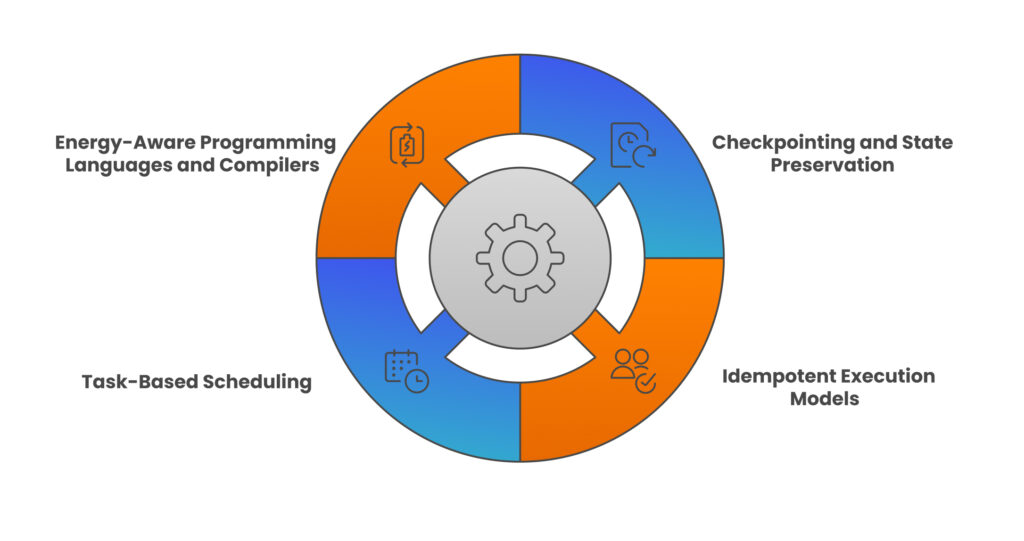As the Internet of Things (IoT) ecosystem continues to grow, it is increasingly supporting a wide range of smart sensors and devices. Many of these devices are deployed in remote areas or environments with limited infrastructure, which has raised significant concerns about the availability of energy to power them.
Conventional energy sources, such as batteries, are inappropriate for long-term sustainability, particularly when access to devices is hindered or difficult. Intermittent computing offers a groundbreaking alternative and potential for irregularly powered or energy-harvested embedded systems to operate reliably despite limited power availability.
This blog explores the concepts, mechanisms, and breakthroughs in intermittent computing, examining how this technique enables embedded functions in energy-harvested devices. It will also discuss the contributions of advancements in embedded system design and the role of solution providers, such as Tessolve, in enabling robust embedded applications.
What is Intermittent Computing?
Intermittent computing refers to a system’s ability to execute tasks in an environment where energy loss is frequent and unpredictable, often resulting in intermittent power outages. Rather than stopping or performing a complete restart due to energy depletion, a system periodically saves its state and can resume its previous operations when energy availability permits. This is especially important for energy-harvested environments where power is gleaned from ambient sources such as solar, kinetic, thermal, or radio frequency (RF).
Energy harvesting may sound sustainable, but it brings a host of challenges:
- The harvested energy is minimal and inconsistent.
- Devices must operate in low-duty cycles.
- Power interruptions can lead to data corruption and loss of execution context.
Intermittent computing directly addresses these issues, enabling reliable, continuous computation on devices without stable power supplies.
How It Works: Key Mechanisms of Intermittent Systems

1. Checkpointing and State Preservation
One of the pillars of intermittent computing is non-volatile memory (NVM) based checkpointing. The system periodically saves processor states, memory, and I/O progress to non-volatile storage. Upon power restoration, the system reloads this data to resume operations.
2. Idempotent Execution Models
Code execution in intermittent computing must often be idempotent, meaning repeated executions have the same effect as a single run. This avoids errors in case of incomplete task execution due to a power failure.
3. Task-Based Scheduling
Intermittent systems use a task-oriented design where each task is small and self-contained. Tasks are atomically executed, and a new task only begins once the previous one has been safely completed and stored.
4. Energy-Aware Programming Languages and Compilers
New tools and languages like Chain, Alpaca, and Mayfly assist in developing robust intermittent programs by integrating checkpointing and state-saving into the compile-time pipeline.
Real-World Applications
1. Environmental Monitoring
Remote sensors used in agriculture or conservation frequently rely on solar energy. Intermittent computing allows them to operate efficiently over the years, even during prolonged cloudy periods.
2. Smart Infrastructure
Wearable and implantable medical devices, or structural health monitors on bridges and buildings, benefit from intermittent systems due to their low maintenance and reliability in the field.
3. Industrial IoT (IoT)
Factories using asset trackers or smart tags in rugged environments can’t always guarantee a power supply. Intermittent systems make these applications robust and energy-efficient.
Challenges in Intermittent Computing
Despite its potential, intermittent computing is not without its hurdles:
- Overhead of Checkpointing: Writing to NVM consumes energy and time.
- Data Consistency: Ensuring accurate state restoration across all components can be complex.
- Limited Support in Commercial Platforms: Many traditional embedded design solution toolchains don’t yet natively support intermittent computing, making development slow and error-prone.
Nonetheless, growing academic and industry interest is leading to improved tool support, runtime systems, and hardware-software co-design methodologies.
Role of Embedded System Design in Intermittent Computing
To build effective intermittent systems, developers must rethink conventional embedded system design principles. Hardware needs to be optimized for ultra-low power consumption, with a blend of volatile and non-volatile memories. Microcontrollers with built-in energy management units are preferred, along with intelligent firmware that knows when to store or restore state.
A well-architected embedded design solution incorporates:
- Hardware support for low-power states
- Non-volatile data memory and efficient storage protocols
- Compiler assistance for power-aware code generation
- Runtime software that orchestrates task execution and recovery
These elements must be carefully synchronized to maintain system integrity and performance under intermittent energy conditions.
Trusted Embedded System Companies Leading the Way
An embedded system company must offer more than just hardware. It should deliver a holistic package of tools, libraries, and services that cater to modern power-aware applications. Companies developing solutions for intermittent systems are now focusing on co-design frameworks that align software structure with hardware capabilities. From edge device development to firmware integration, these companies are driving innovation in how embedded systems are built for real-world sustainability.
Why Tessolve Stands Out in Embedded System Innovation
At Tessolve, we recognize the growing demand for embedded solutions that are not only high-performance but also energy-efficient and adaptable to intermittent power conditions. Our embedded design solution services are engineered to meet these challenges head-on, supporting clients from concept to deployment with an end-to-end approach that spans silicon to system.
Our embedded offerings include:
- Embedded board design, development, and validation
- BSP (Board Support Package) and firmware development
- Comprehensive test automation and validation frameworks
- Power optimization strategies for energy-harvested and low-power systems
- Expertise across multiple processor architectures and real-time operating systems (RTOS)
With a focus on performance, scalability, and energy efficiency, Tessolve’s multidisciplinary teams work closely with clients to build embedded solutions that are robust, reliable, and production-ready. Our experience with both conventional and next-generation applications, such as those relying on intermittent computing, positions us as a trusted partner in navigating complex design requirements and accelerating time-to-market.
Also Read: From Silent Machines to Speaking Devices: How IoT is Giving a Voice to Everyday Objects
Conclusion: Sustaining the Future with Smarter Systems
Intermittent computing marks a significant shift in embedded system design—moving away from traditional, power-dependent models to intelligent, resilient architectures that thrive in unpredictable energy environments. As energy-harvested devices become central to IoT and edge deployments, this approach offers a sustainable pathway to innovation.
Success in this domain depends not only on the right technologies but also on the right partners. Tessolve brings deep expertise in embedded design, power optimization, and end-to-end system development, making us a trusted collaborator in building robust, low-power solutions that are ready for real-world deployment.
If you’re aiming to develop smarter, energy-aware embedded systems, Tessolve is here to help you lead with confidence in a rapidly evolving technology landscape.
